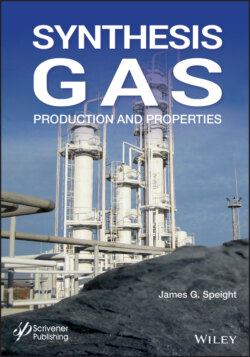Читать книгу Synthesis Gas - James Speight G., James G. Speight - Страница 16
1.2.3 Extra Heavy Crude Oil and Tar Sand Bitumen
ОглавлениеIn addition to conventional crude oil and heavy crude oil, there remains an even more viscous material that offers some relief to the potential shortfalls in supply (Meyer and De Witt, 1990; Meyer and Attanasi, 2003; Speight, 2014; BP, 2019). This is the bitumen known as extra heavy crude oil and the bitumen found in tar sand (oil sand) deposits (Table 1.1). However, many of these reserves are only available with some difficulty and optional refinery scenarios will be necessary for conversion of these materials to liquid products (Speight, 2000, 2014a) because of the substantial differences in character between conventional crude oil and tar sand bitumen (Speight, 2014a).
Table 1.1 Simplified differentiation between conventional crude oil, tight oil, heavy crude oil, extra heavy crude oil, and tar sand bitumen*.
| Conventional Crude Oil |
| Mobile in the reservoir; API gravity: >25o |
| High-permeability reservoir |
| Primary recovery |
| Secondary recovery |
| Tight Oil |
| Similar properties to the properties of conventional crude oil; API gravity: >25o |
| Immobile in the reservoir |
| Low-permeability reservoir |
| Horizontal drilling into reservoir |
| Fracturing (typically multi-fracturing) to release fluids/gases |
| Heavy Crude Oil |
| More viscous than conventional crude oil; API gravity: 10-20o |
| Mobile in the reservoir |
| High-permeability reservoir |
| Secondary recovery |
| Tertiary recovery (enhanced oil recovery – EOR; e.g. steam stimulation) |
| Extra Heavy Crude Oil |
| Similar properties to the properties of tar sand bitumen; API gravity: <10o |
| Mobile in the reservoir |
| High-permeability reservoir |
| Secondary recovery |
| Tertiary recovery (enhanced oil recovery – EOR; e.g. steam stimulation) |
| Tar Sand Bitumen |
| Immobile in the deposit; API gravity: <10o |
| High-permeability reservoir |
| Mining (often preceded by explosive fracturing) |
| Steam assisted gravity draining (SAGD) |
| Solvent methods (VAPEX) |
| Extreme heating methods |
| Innovative methods** |
* This list is not intended for use as a means of classification.
** Innovative methods excludes tertiary recovery methods and methods such as steam assisted gravity drainage (SAGD) and vapor assisted extraction (VAPEX) methods but does include variants or hybrids thereof.
Extra heavy crude oil is a nondescript term (related to viscosity) of little scientific meaning that is usually applied to tar sand bitumen, which is generally capable of free flow under reservoir conditions (Table 1.1). Thus, general difference is that extra heavy crude oil, which may have properties similar to tar sand bitumen in the laboratory but, unlike tar sand bitumen in the deposit, has some degree of mobility in the reservoir or deposit (Table 1.1) (Delbianco and Montanari, 2009; Speight, 2014a). Extra heavy crude oils can flow at reservoir temperature and can be produced economically, without additional viscosity-reduction techniques, through variants of conventional processes such as long horizontal wells, or multilaterals. This is the case, for instance, in the Orinoco basin (Venezuela) or in offshore reservoirs of the coast of Brazil but, once outside of the influence of the high reservoir temperature, these oils are too viscous at surface to be transported through conventional pipelines and require heated pipelines for transportation. Alternatively, the oil must be partially upgraded or fully upgraded or diluted with a light hydrocarbon (such as aromatic naphtha) to create a mix that is suitable for transportation (Speight, 2014a, 2017).
Tar sand (referred to as oil sand in Canada) deposits are found in various countries throughout the world, but in vast quantities in Alberta and Venezuela. There have been many attempts to define tar sand deposits and the bitumen contained therein. In order to define conventional crude oil, heavy crude oil, and bitumen, the use of a single physical parameter such as viscosity is not sufficient. Other properties such as API gravity, elemental analysis, composition, and, most of all, the properties of the bulk deposit must also be included in any definition of these materials. Only then will it be possible to classify crude oil and its derivatives.
In fact, the most appropriate and workable definition of tar sand is found in the writings of the United States government (US Congress, 1976), which is not subject to any variation in chemical or physical properties that can vary depending upon the method of property determination and the accuracy of that method (Speight, 2014), viz.:
Tar sands are the several rock types that contain an extremely viscous hydrocarbon which is not recoverable in its natural state by conventional oil well production methods including currently used enhanced recovery techniques. The hydrocarbon-bearing rocks are variously known as bitumen-rocks oil, impregnated rocks, oil sands, and rock asphalt.
This definition speaks to the character of the bitumen through the method of recovery (Speight, 2014, 2016). Thus, the bitumen found in tar sand deposits is an extremely viscous material that is immobile under reservoir conditions and cannot be recovered through a well by the application of secondary or enhanced recovery techniques.
By inference and by omission, conventional crude oil and heavy crude oil are also included in this definition. Extra heavy oil can also be accommodated under this definition because the oil approximates the properties and behavior of tar sand bitumen at ambient conditions but is mobile because the reservoir temperature is higher than the pour point of the oil (Table 1.1). Crude oil is the material that can be recovered by conventional oil well production methods whereas heavy crude oil is the material that can be recovered by enhanced recovery methods. Tar sand currently recovered by a mining process followed by separation of the bitumen by the hot water process. The bitumen is then used to produce hydrocarbon derivatives by a conversion process.
